How to Get Rid Of Groundhogs
50 min read Updated for November, 2019
Groundhogs carry a certain amount of lore in popular culture. Whole regions of the Northeast rely on them to predict the seasons, and they’ve inspired at least one classic comedy. But groundhogs, also known as woodchucks or whistle pigs, can cause serious problems for homeowners and farmers when they consume crops, undermine home foundations, and chew through electrical wires and piping.
50 min read Updated for November, 2019

Groundhog Sounds
Groundhogs are also known as whistle pigs due to the shrill whistle they can make, usually when warning other groundhogs of nearby predators, and are known to chatter their teeth when angered or cornered. When feeding they tend to make a low warble that almost sounds like a “chuck-chuck” sound and communicate with others via barks, growls and hisses.
Groundhog Tracks
Groundhogs have four toes (with distinctive claws) on their front paws and five toes on the back, measuring about one and a half inches long. Depending whether they’re walking or running, the tracks should be spaced between four to twelve inches apart.
Groundhog Poop
One of the more tidier animals, groundhogs include toilet facilities in the burrows they dig underground, but similar to other rodents, their dropping are medium-sized, oval shaped and typically dark brown or black in color.
Identify
Groundhogs are closely related to marmots and fall under the broader category of squirrels. These rodents are very similar to other types of ground squirrels in that they burrow, eat herbs primarily, and are usually solitary creatures. The more specifics you know about groundhogs, the easier it is to distinguish them from similar rodents.
Physical Characteristics
Groundhogs are larger and more heavy-bodied in appearance than many species in the rodent family. Here’s how to tell them apart.
Color:
Groundhogs can range from light to dark brown or even black, with lighter underbellies.
Tail:
Their tails are bushy and usually between five to seven inches.
Teeth:
Groundhogs are power chewers thanks to their long incisors, which grow one-sixteenth of an inch each week.
Size:
Groundhogs are larger than most other rodents, ranging from 16 to 20 inches and weighing up to 13 pounds.
Ears and eyes:
Because they need to stay concealed while scanning for predators, groundhog ears and eyes are small and located near the top of the head.
Legs:
Powerful, short limbs make groundhogs efficient burrowers.
Claws:
Strong, curved claws also help them dig.
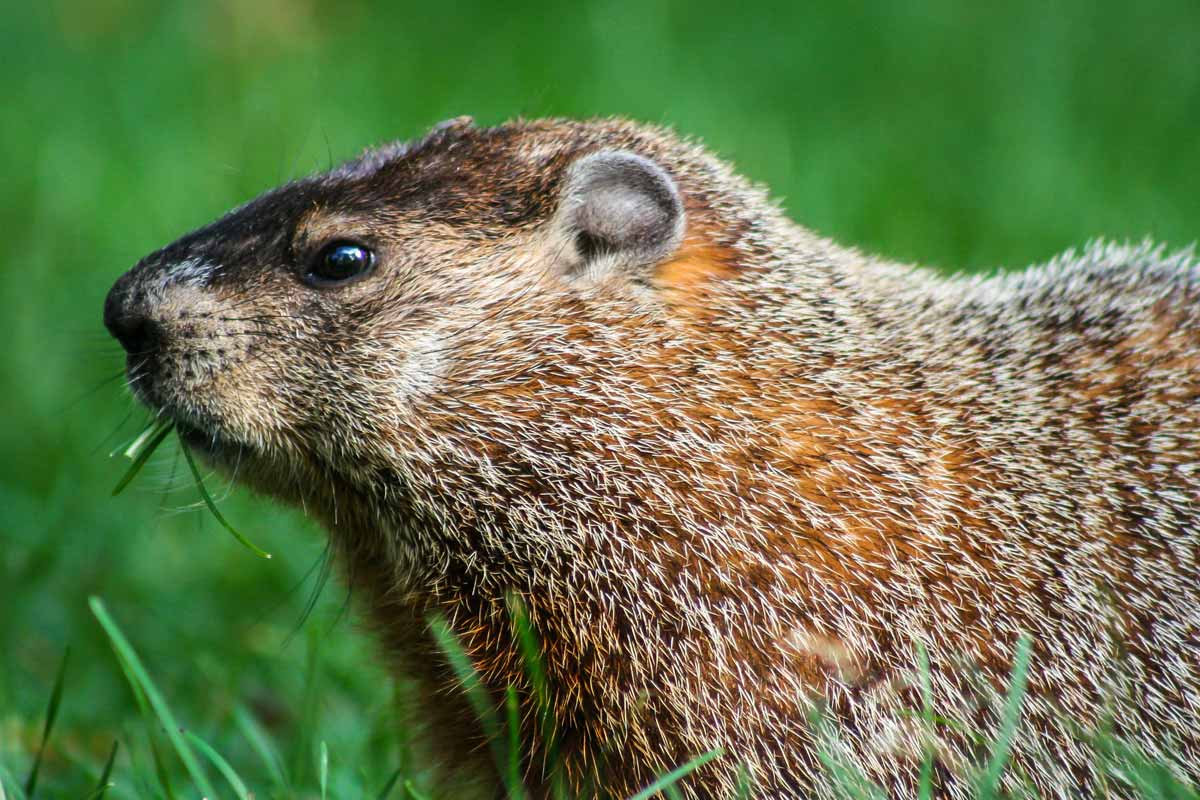
Behavior
Groundhogs share many behaviors with their fellow rodent species, but they’re distinct in other ways. Unlike their subterranean cousin’s moles and voles, for instance, they’re not afraid to venture from their burrows. Notable behavior includes:
- Do not hoard food like other species, but rather, eat as much as possible to build fat reserves for winter
- Usually solitary creatures, although occasionally will share burrows
- Burrows contain separate chambers for depositing waste and nesting
- Spend more time above ground than some burrowers, whether sunbathing or foraging
- Primarily eat herbs but may occasionally branch out to insects or even (very rarely) small animals
- One of the few mammals to hibernate during winter
- Are competent swimmers and climbers, although they prefer to stay on the ground
- Their burrows provide homes for other animals, like foxes, smaller rodents, and other animals
- Have two separate burrows for summer and winter
Habitat
Groundhogs occupy a vast territory across the Northeast and Canada, encompassing many different landscapes. Here’s where you’re most likely to find them.
- Where wooded areas fade into clearings, often near highways or fields
- Where there’s adequate foliage, particularly if favorites like clover and alfalfa are available
- In dry areas where the soil can support a burrow structure
- Near farmland and pastures
Geography
While they’re most famous in the Northeast area of the U.S., groundhogs can range as far North as Alaska and as far South as Alabama.
- Mostly occupy the Western and central parts of the U.S.
- Spread throughout most of Southern Canada
- Largest rodent in its range
Life Cycle
Like most rodents, groundhogs only mate once a year. Here’s what you should know about their reproduction cycle.
- Do not mate until their second year of life, except in rare cases
- Litters produce two to six kits
- Male and female groundhogs mate in the spring after waking from hibernation
- Males stay with females for about one month after mating but leave before the kits are born
- Kits are blind and hairless
- Female groundhogs rear young alone
- Young groundhogs leave the nest after six weeks and venture off on their own in the fall
- Groundhogs live from four to six years
Common Species
Groundhogs bear many similarities to other rodents, particularly other large ground squirrels. They’re perhaps most often confused with prairie dogs and gophers, but you can tell them apart easily when you know these characteristics.
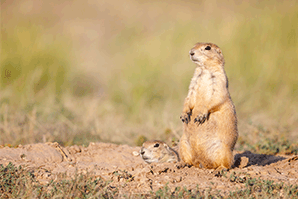
Groundhogs vs. Prairie Dogs
Both of these animals are a member of the same scientific family, called Sciuridae. While they do share a long list of traits, they’re still distinguishable by a few features.
Appearance
Groundhogs are considerably larger than prairie dogs. Prairie dogs max out at three pounds, while groundhogs can weigh up to 13 (although most range between five to nine). Prairie dogs also have thinner fur than groundhogs because they live in warmer territories.
Behavior
Prairie dogs are much more communal creatures than groundhogs. They live in large colonies, raise their young together, and even feed in groups, with one prairie dog standing watch while the others eat. They also stay active during the winter, unlike groundhogs who hibernate, although they may remain in their burrows and sleep during the coldest days of the year.
Geography
Prairie dogs occupy much of the plains in the Central and Western U.S., while groundhogs are more likely to live in the East. Because much of the prairie dog’s territory is now farmland, many of them have been evicted, severely hurting their populations.
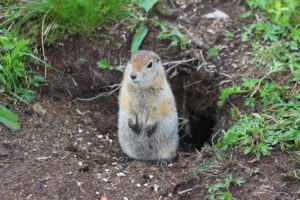
Groundhogs vs. Gophers
Though they’re both a part of the order of rodents, groundhogs and gophers are members of different families (the scientific classification beneath rodents). Groundhogs are members of the marmot family, which contains other larger rodents like chipmunks and prairie dogs. Gophers are in the Geomyoidae family, making them more similar to certain kinds of rats and mice. You can tell them apart by these characteristics.
Feeding habits
Unlike gophers, groundhogs do not carry food in their cheeks and store it in burrows. In fact, they don’t hoard food for the winter at all. Because they hibernate, they instead consume as much food as possible so they can rely on fat stores during the colder months.
Appearance
Groundhogs are significantly bigger than gophers, which rarely exceed two pounds. Groundhogs also have fur-covered, dark brown or black paws while gophers are typically pink and hairless. You can also tell a difference between their tails: gopher tails are shorter and hairless and groundhog tails are longer and full. Gophers also can’t close their mouths over their teeth (which helps them avoid ingesting dirt while digging), but groundhogs can.
Behavior
You’re much more likely to see a groundhog than a gopher. That’s because gophers are much more skittish about venturing above ground than their cousin the groundhog. Gophers will only risk moving a few feet from their burrow, while groundhogs happily forage and sunbathe outside during the day.
Common Locations
As we mentioned before, groundhogs thrive in open forest or in clearings that are close to wooded areas. You can find them near farms, gardens, or anywhere that offers lush vegetation.
Treating Your Property For Groundhogs
Trapping a groundhog may be overkill for some homeowners, especially if the animal is more of a nuisance than a serious threat to the property. If you’re in that situation and you’d prefer to try other treatment methods first, there are quite a few options. These include both natural and store-bought repellents, as well as sound devices. Here are a few treatment products you may want to consider.
DIY Treatments
If you want to repel groundhogs without spending money, you’re in luck. There are many items you probably already have around your house that can deter groundhogs from making a home in your yard. Here are some DIY treatment ideas to try before you buy.
Garlic
Groundhogs can’t stand the smell of garlic, so try placing cloves of it around their burrow entrance. You can also try mixing diced garlic with water and spraying it directly on your plants to protect them.
Castor oil
Most rodents detest the smell of castor oil, which makes it an excellent all-purpose repellent. You can pour castor oil around or into their burrows or create a solution by adding water, which can then be used to spray the garden.
Hot spices
Groundhogs aren’t fans of spicy-smelling foods like hot peppers. This means you may be able to scare them away naturally by using spices from your kitchen. Try cayenne, chili pepper, and red pepper flakes.
Used kitty litter
It may come as a surprise, but used kitty litter may play a role in keeping your yard groundhog free. Cats and other domestic pets like dogs are natural predators of groundhogs, and so spreading their waste around can scare scent-sensitive groundhogs away.
Epsom salts
This is another scent that groundhogs avoid. Sprinkle some salts near their burrows and on the garden itself.
Groundhog Problem?
Groundhogs prefer well-drained soil and easy access to the plants that they love to eat.
Why They’re There
If your yard has groundhogs, it can be helpful to know what drew them there in the first place. Groundhogs prefer well-drained soil and easy access to the plants that they love to eat. Here are a few features that may make your land particularly attractive.
Food
Groundhogs are herbivores, meaning they only eat plants, although they will occasionally eat grub or other insects. They like short grasses and an array of vegetables, including clover, soybeans, alfalfa, and peas, among others. If your yard or garden offers these foods, they’re much more likely to spend time there. Surprisingly, groundhogs do not seem to need to drink water to survive; instead, they get most of their hydration from juicy vegetables or the dew on the grass they eat.
Landscape
Groundhogs are lowland dwellers, unlike some other rodents that prefer rocky or mountainous terrain. They do, however, need soil that’s dry and firm enough to burrow in. They will avoid any land that’s swampy or damp.
Groundhog Sounds
Groundhogs are also known as whistle pigs due to the shrill whistle they can make, usually when warning other groundhogs of nearby predators, and are known to chatter their teeth when angered or cornered. When feeding they tend to make a low warble that almost sounds like a “chuck-chuck” sound and communicate with others via barks, growls and hisses.
Groundhog Tracks
Groundhogs have four toes (with distinctive claws) on their front paws and five toes on the back, measuring about one and a half inches long. Depending whether they’re walking or running, the tracks should be spaced between four to twelve inches apart.
Groundhog Poop
One of the more tidier animals, groundhogs include toilet facilities in the burrows they dig underground, but similar to other rodents, their dropping are medium-sized, oval shaped and typically dark brown or black in color.
Inspect
Groundhogs are not as shy as some other rodent burrowers. They spend much of their time grazing, basking in sunlight, and even sleeping above ground, which makes them easier to spot. Beyond that, groundhogs are substantially larger than most other rodents, which should make them simple to recognize.
Should I Relocate This Animal?
You should always run a cost-benefit analysis before deciding to relocate a groundhog—or several groundhogs—from your property. While they get a bad rap, they can be an important helper in maintaining a healthy ecosystem.
Risk of disease or injury
Groundhogs usually try to flee rather than fight, but that doesn’t mean they won’t resort to biting if they feel cornered. In addition, groundhogs can carry rabies as well as several other diseases, so you’ll want to proceed with extreme caution if you do decide to use live traps.
Cost
Catching and moving the groundhog may require buying new equipment. However, if the groundhog is causing significant—and expensive—damage, it may be worth the cost of removal.
Ecological benefits
While they may not seem particularly useful to humans, groundhogs can serve the overall ecosystem. The burrows they build can provide homes for many other critters, including reptiles and other rodents, which may in turn help control the insect populations that these animals eat.
Time
Groundhog burrows often have several exits, which means that it may take some trial and error to catch the animal in question. You will also need to wait until the right season. It’s considered inhumane to catch a groundhog mother while she’s raising her young, for example, in spring and early summer. Most experts recommend laying your trips in late summer.
Gather The Tools You’ll Need
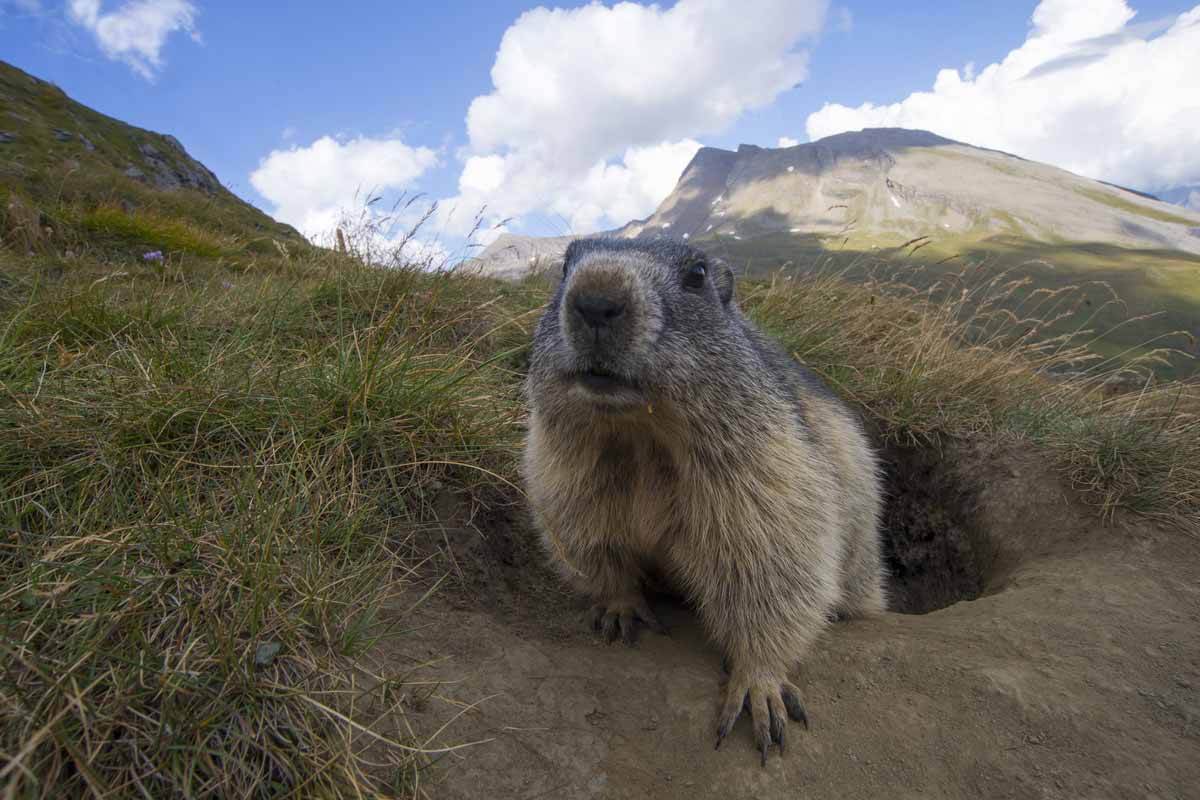
Leather gloves
Protects your hands if you come into contact with a groundhog and also helps conceal your scent so it won’t scare away the animal you’re trying to catch.
A live-catch trap
You’ll need to purchase a trap that’s both large enough to hold a groundhog and sturdy enough to prevent it from escaping. Like we mentioned earlier, groundhogs are excellent chewers, so you’ll want a trap that’s made from metal or sturdy plastic.
Shovel
You may need to clear away excess dirt to reach the burrow’s entrance.
Bait
Expert trappers recommend that you change the bait daily. Try using one of the groundhog’s favorite foods, like alfalfa, carrot tops, or soybeans.
Tarp
Protects your vehicle from animal waste during transport.
Blanket
Can be placed on top of the trap during transport to calm the scared animal.
How-To Steps for DIY Removal
If you’ve decided to catch your groundhog with a live trap, follow these steps. Keep in mind that groundhogs can have more than one burrow—and that more than one groundhog can share the same burrow.
Treating Your Property For Groundhogs
Trapping a groundhog may be overkill for some homeowners, especially if the animal is more of a nuisance than a serious threat to the property. If you’re in that situation and you’d prefer to try other treatment methods first, there are quite a few options. These include both natural and store-bought repellents, as well as sound devices. Here are a few treatment products you may want to consider.
DIY Treatments
If you want to repel groundhogs without spending money, you’re in luck. There are many items you probably already have around your house that can deter groundhogs from making a home in your yard. Here are some DIY treatment ideas to try before you buy.
Garlic
Groundhogs can’t stand the smell of garlic, so try placing cloves of it around their burrow entrance. You can also try mixing diced garlic with water and spraying it directly on your plants to protect them.
Castor oil
Most rodents detest the smell of castor oil, which makes it an excellent all-purpose repellent. You can pour castor oil around or into their burrows or create a solution by adding water, which can then be used to spray the garden.
Hot spices
Groundhogs aren’t fans of spicy-smelling foods like hot peppers. This means you may be able to scare them away naturally by using spices from your kitchen. Try cayenne, chili pepper, and red pepper flakes.
Used kitty litter
It may come as a surprise, but used kitty litter may play a role in keeping your yard groundhog free. Cats and other domestic pets like dogs are natural predators of groundhogs, and so spreading their waste around can scare scent-sensitive groundhogs away.
Epsom salts
This is another scent that groundhogs avoid. Sprinkle some salts near their burrows and on the garden itself.
Groundhog Problem?
Woodchuck holes will be wide—up to 10 inches—and will have dirt deposits surrounding them.
How to trap a live groundhog
Step 1: Identify the burrow entrance. Keep in mind that some burrows may have several openings and others may have only one. However, they’re reasonably easy to distinguish by appearance. Woodchuck holes will be wide—up to 10 inches—and will have dirt deposits surrounding them. Make sure you have the relocation site in mind before you begin trapping.
Step 2: Set the trap. Luckily for homeowners, groundhog traps typically don’t require much or any digging. Once you’ve found the burrow entrance, place the trap directly on top and wait for the groundhog to walk in. They’re not as discriminating as other rodents, like gophers, who may require burying the trap mid-tunnel.
Step 3: Bait the trap. Groundhogs love many types of vegetables and legumes. Try adding broccoli, peas, or alfalfa. Some trappers even recommend cantaloupe.
Step 4: Wait. Groundhogs are active during the day, especially during the early morning or late afternoon, so you may have better luck with catching them then.
Step 5: Relocate the groundhog. Make sure you’ve obtained permission from the landowner and found a location that’s appropriate to the groundhog’s needs, i.e., is lightly wooded or open with adequate vegetation. Also, consider throwing a blanket over the cage to comfort the frightened animal.
Step 6: Release.
Step 7: Fill in burrows.
Avoid conibear traps as they can easily harm or kill domestic pets and other animals.
Methods to avoid
Conibear traps: Many experts advise avoiding these traps as they can easily harm or kill domestic pets and other animals. While they’re highly effective at killing groundhogs, they’re considered inhumane and dangerous to other wildlife.
Risks Of Disease
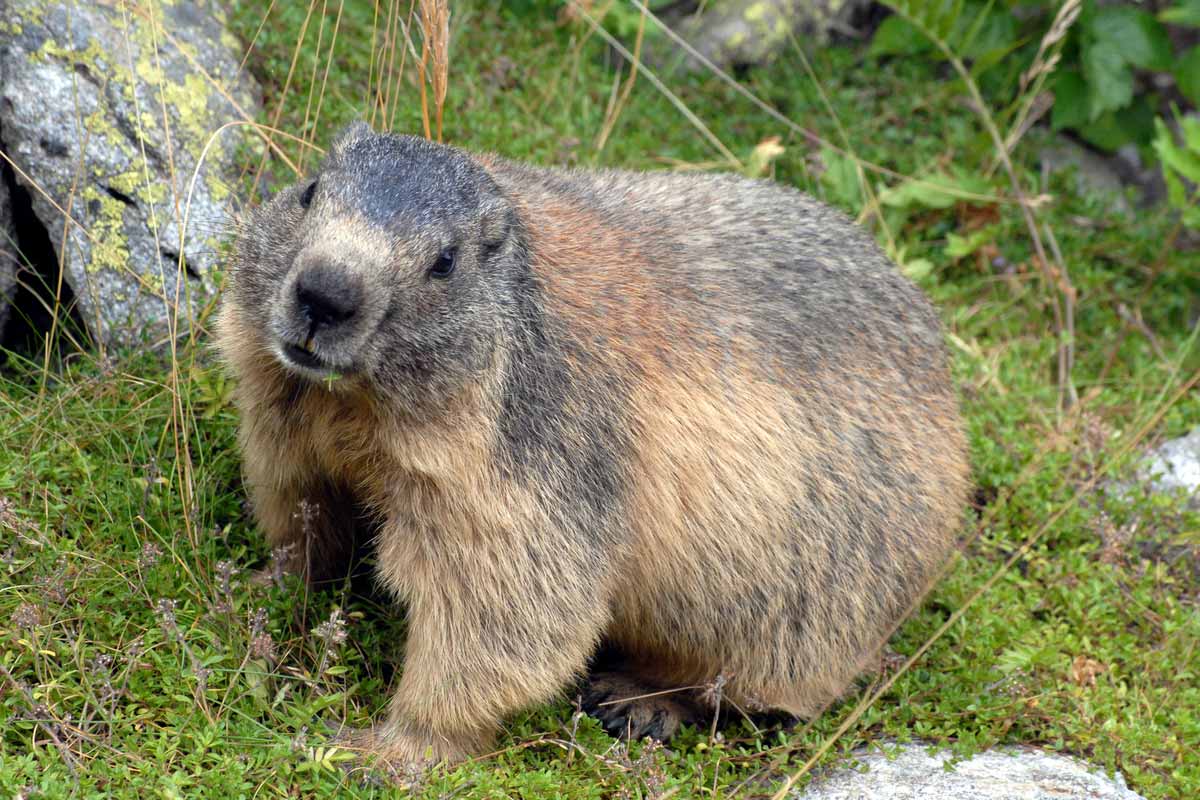
Plague
This disease can be contracted from fleas carried by groundhogs or from handling a groundhog directly. Once a person is infected, the disease will attack the immune system and cause symptoms like fever, chills, weakness, and headache. Though it is curable with antibiotics, plague can become deadly when left untreated.
Leptospirosis
This disease is spread through the urine of infected animals, often rodents. If a groundhog or other infected rodent has accessed your food or water supply, you may be at risk of contracting this disease. Seek immediate medical attention if you experience symptoms like fever, diarrhea, vomiting, and jaundice.
Salmonellosis
Exposure to animal feces causes this illness and can also cause diarrhea and gastrointestinal distress in humans. While unpleasant, this infection typically goes away on its own within a few days.
Tularemia
This bacterial infection can be contracted by handling or even mowing over a deceased groundhog. Symptoms vary, but antibiotics can treat this serious disease.
Rabies
Rabies in groundhogs is rare, but it’s happened before. Groundhogs are not aggressive toward humans by nature, so if one charges or attempts to bite you without provocation, it may be infected. Seek immediate attention if a groundhog bites you.
Groundhog Sounds
Groundhogs are also known as whistle pigs due to the shrill whistle they can make, usually when warning other groundhogs of nearby predators, and are known to chatter their teeth when angered or cornered. When feeding they tend to make a low warble that almost sounds like a “chuck-chuck” sound and communicate with others via barks, growls and hisses.
Groundhog Tracks
Groundhogs have four toes (with distinctive claws) on their front paws and five toes on the back, measuring about one and a half inches long. Depending whether they’re walking or running, the tracks should be spaced between four to twelve inches apart.
Groundhog Poop
One of the more tidier animals, groundhogs include toilet facilities in the burrows they dig underground, but similar to other rodents, their dropping are medium-sized, oval shaped and typically dark brown or black in color.
Prevent
Relocating your groundhog is only half the battle. Their elaborate and well-excavated tunnels can invite other groundhogs—and other types of rodents—to make a home in your yard even after you’ve removed the offending creature. If you’ve recently relocated a groundhog from your property, or you’re just looking to prevent future run-ins with this rodent, try these methods.
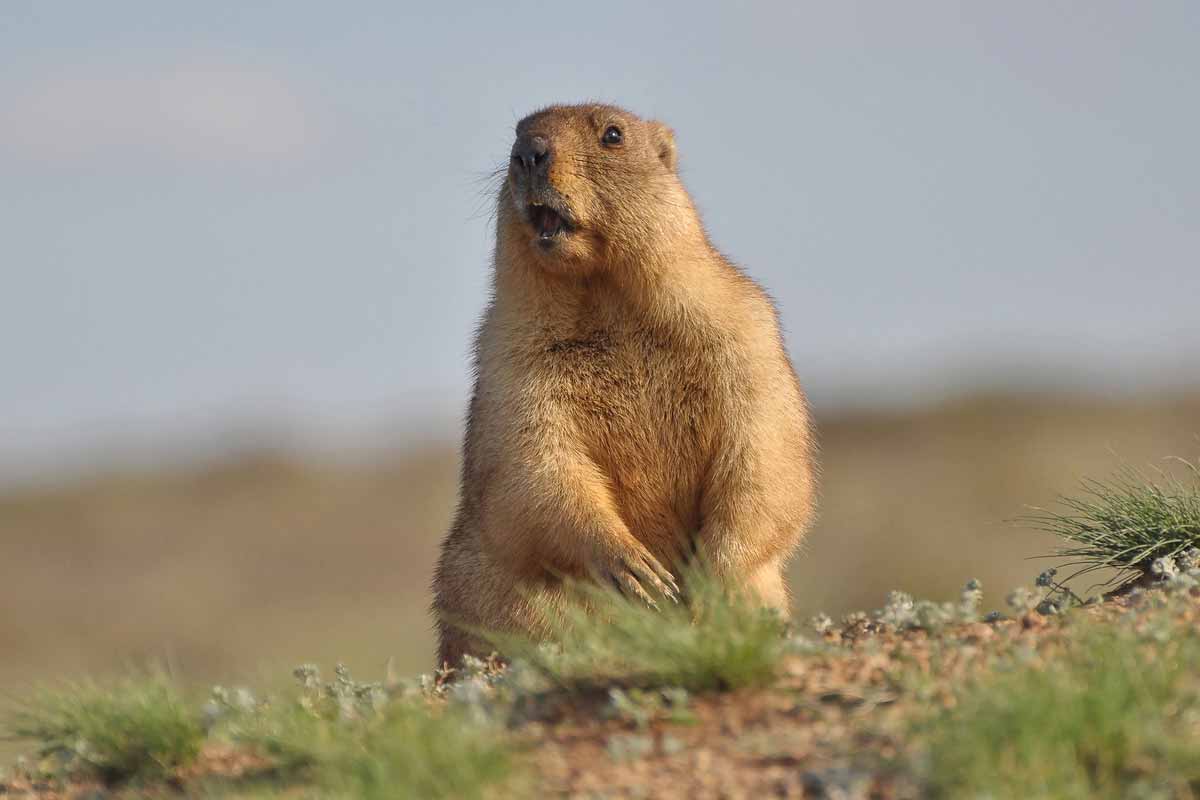
Prevention Methods
- Avoid planting groundhog favorites. These can include soybeans, carrot tops, peas, dandelions, alfalfa, and grasses. If you can’t avoid growing these varieties, consider the following methods instead.
- Install an electric fence. The fence will need to be about nine inches off the ground (higher if you want to prevent other animals from invading).
- Install a non-electric fence. Non-electric fences will need to have a fine metal mesh that prevents even small groundhogs from squeezing through. Experts recommend the mesh be two inches by two inches or even smaller. It will also need to be three fight high and reach about a foot underground.
- Because their front teeth grow so quickly, woodchucks need to chew constantly. Remove any old logs, stumps, or other debris that woodchucks could use to grind down their incisors.
- Some master gardeners recommend planting a crop that’s solely for groundhogs to eat. Use one of the groundhog’s favorites like alfalfa or soybeans and keep this plant far away from the rest of your garden.
- Use scare tactics, like placing a helium balloon or beach ball in your garden on a string. These can catch the wind and create movement, which may scare the cautious groundhogs.
- Keep grass well trimmed. Groundhogs prefer the cover of high grasses and weeds as they move above ground, so cutting your lawn may discourage them from exploring.
- Try using a device that makes disruptive sounds (which are not audible to humans) that may annoy groundhogs.
- Remove vegetation from near their burrows, forcing them to journey farther to find food.
Treating Your Property For Groundhogs
Trapping a groundhog may be overkill for some homeowners, especially if the animal is more of a nuisance than a serious threat to the property. If you’re in that situation and you’d prefer to try other treatment methods first, there are quite a few options. These include both natural and store-bought repellents, as well as sound devices. Here are a few treatment products you may want to consider.
DIY Treatments
If you want to repel groundhogs without spending money, you’re in luck. There are many items you probably already have around your house that can deter groundhogs from making a home in your yard. Here are some DIY treatment ideas to try before you buy.
Garlic
Groundhogs can’t stand the smell of garlic, so try placing cloves of it around their burrow entrance. You can also try mixing diced garlic with water and spraying it directly on your plants to protect them.
Castor oil
Most rodents detest the smell of castor oil, which makes it an excellent all-purpose repellent. You can pour castor oil around or into their burrows or create a solution by adding water, which can then be used to spray the garden.
Hot spices
Groundhogs aren’t fans of spicy-smelling foods like hot peppers. This means you may be able to scare them away naturally by using spices from your kitchen. Try cayenne, chili pepper, and red pepper flakes.
Used kitty litter
It may come as a surprise, but used kitty litter may play a role in keeping your yard groundhog free. Cats and other domestic pets like dogs are natural predators of groundhogs, and so spreading their waste around can scare scent-sensitive groundhogs away.
Epsom salts
This is another scent that groundhogs avoid. Sprinkle some salts near their burrows and on the garden itself.
Groundhog Problem?
Groundhog Sounds
Groundhogs are also known as whistle pigs due to the shrill whistle they can make, usually when warning other groundhogs of nearby predators, and are known to chatter their teeth when angered or cornered. When feeding they tend to make a low warble that almost sounds like a “chuck-chuck” sound and communicate with others via barks, growls and hisses.
Groundhog Tracks
Groundhogs have four toes (with distinctive claws) on their front paws and five toes on the back, measuring about one and a half inches long. Depending whether they’re walking or running, the tracks should be spaced between four to twelve inches apart.
Groundhog Poop
One of the more tidier animals, groundhogs include toilet facilities in the burrows they dig underground, but similar to other rodents, their dropping are medium-sized, oval shaped and typically dark brown or black in color.
When to Call a Professional
If you see significant damage from groundhogs, it may be time to call a professional. While they’re not always harmful to humans, these animals can sometimes cause substantial damage by compromising the foundation of homes, chewing through buried electrical wire, and destroying crops and gardens. If your prevention and treatment methods have failed, and you prefer not to risk trapping, consider calling an experienced exterminator to help.
Sources
https://pss.uvm.edu/ppp/articles/woodchucks.html
https://extension.unh.edu/resources/files/resource000562_rep584.pdf
https://www.huffingtonpost.com/2013/02/01/groundhogs-in-your-garden_n_2593390.html
https://www.cdc.gov/rodents/diseases/direct.html
http://icwdm.org/Inspection/GroundHoles.aspx
http://www.differencebetween.net/science/nature/difference-between-prairie-dog-and-groundhog/
http://www.aaanimalcontrol.com/professional-trapper/howtogetridofgroundhogs.html
https://animals.mom.me/differences-between-groundhogs-gophers-5020.html
http://www.newworldencyclopedia.org/entry/Groundhog
https://www.massaudubon.org/learn/nature-wildlife/mammals/woodchucks-groundhogs/about
https://www.britannica.com/animal/groundhog
https://www.nationalgeographic.com/animals/mammals/g/groundhog/
https://www.humanesociety.org/resources/what-do-about-woodchucks
Treating Your Property For Groundhogs
Trapping a groundhog may be overkill for some homeowners, especially if the animal is more of a nuisance than a serious threat to the property. If you’re in that situation and you’d prefer to try other treatment methods first, there are quite a few options. These include both natural and store-bought repellents, as well as sound devices. Here are a few treatment products you may want to consider.
DIY Treatments
If you want to repel groundhogs without spending money, you’re in luck. There are many items you probably already have around your house that can deter groundhogs from making a home in your yard. Here are some DIY treatment ideas to try before you buy.
Garlic
Groundhogs can’t stand the smell of garlic, so try placing cloves of it around their burrow entrance. You can also try mixing diced garlic with water and spraying it directly on your plants to protect them.
Castor oil
Most rodents detest the smell of castor oil, which makes it an excellent all-purpose repellent. You can pour castor oil around or into their burrows or create a solution by adding water, which can then be used to spray the garden.
Hot spices
Groundhogs aren’t fans of spicy-smelling foods like hot peppers. This means you may be able to scare them away naturally by using spices from your kitchen. Try cayenne, chili pepper, and red pepper flakes.
Used kitty litter
It may come as a surprise, but used kitty litter may play a role in keeping your yard groundhog free. Cats and other domestic pets like dogs are natural predators of groundhogs, and so spreading their waste around can scare scent-sensitive groundhogs away.
Epsom salts
This is another scent that groundhogs avoid. Sprinkle some salts near their burrows and on the garden itself.
Groundhog Problem?
Sources
https://www.trutechinc.com/services/groundhog-control/sounds/
https://www.ehow.com/how_2175445_recognize-woodchuck-sounds.html
https://extension.illinois.edu/wildlife/directory_show.cfm?species=woodchuck
https://www.pests.org/groundhog-droppings-identification-and-dangers/
Groundhog Sounds
Groundhogs are also known as whistle pigs due to the shrill whistle they can make, usually when warning other groundhogs of nearby predators, and are known to chatter their teeth when angered or cornered. When feeding they tend to make a low warble that almost sounds like a “chuck-chuck” sound and communicate with others via barks, growls and hisses.
Groundhog Tracks
Groundhogs have four toes (with distinctive claws) on their front paws and five toes on the back, measuring about one and a half inches long. Depending whether they’re walking or running, the tracks should be spaced between four to twelve inches apart.
Groundhog Poop
One of the more tidier animals, groundhogs include toilet facilities in the burrows they dig underground, but similar to other rodents, their dropping are medium-sized, oval shaped and typically dark brown or black in color.





